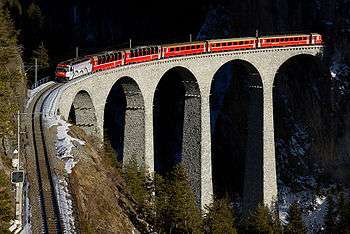Landwasser Viaduct
| Landwasser Viaduct Landwasserviadukt | |
|---|---|
|
A train crossing the viaduct. | |
| Coordinates | 46°40′51″N 9°40′33″E / 46.68083°N 9.67583°ECoordinates: 46°40′51″N 9°40′33″E / 46.68083°N 9.67583°E |
| Carries | Rhaetian Railway (RhB) |
| Crosses | Landwasser |
| Locale | Schmitten and Filisur, Switzerland |
| Official name | Landwasserviadukt |
| Owner | Rhaetian Railway (RhB) |
| Maintained by | Rhaetian Railway (RhB) |
| Heritage status | UNESCO World Heritage Albula Railway |
| Characteristics | |
| Design | Viaduct |
| Material | Limestone |
| Total length | 136 m (446 ft) |
| Height | 65 m (213 ft) |
| Longest span | 20 m (66 ft) |
| Number of spans | 6 |
| Piers in water | 0 |
| History | |
| Designer | Alexander Acatos |
| Constructed by | Müller & Zeerleder |
| Construction begin | March 1901 |
| Construction end | 1902 |
| Construction cost | CHF 280,000 (1902) |
| Opened | October 1902 |
| Rebuilt | 2009 renovation during full usage (CHF 4.6 Million) |
| Statistics | |
| Daily traffic | 30 passenger train, few freight trains |
 View from above. | |
The Landwasser Viaduct (German: Landwasserviadukt) is a single track six-arched curved limestone railway viaduct. It spans the Landwasser between Schmitten and Filisur, in the canton of Graubünden, Switzerland.
Designed by Alexander Acatos, it was built between 1901 and 1902 by Müller & Zeerleder for the Rhaetian Railway, which still owns and uses it today. A signature structure of the World Heritage-listed Albula Railway, it is 65 metres (213 ft) high, 136 metres (446 ft) long, and one of its ramps exits straight into the Landwasser Tunnel.[1]
Description
The Landwasser Viaduct has six arch spans 20 metres (66 ft) in width, resting on five high pillars. The railway line near the viaduct has a slope of 2 percent, and in plan a circular arc with a radius of 100 metres (330 ft).
The southeastern abutment of the viaduct is located on a high cliff, and at that point, the tracks lead directly into the 216 metres (709 ft) long Landwasser Tunnel.
The viaduct's masonry is approximately 9,200 cubic metres (320,000 cu ft) in volume and is jointed with dolomitic limestone.[2]
Location
The dark limestone-built viaduct forms part of the Albula Railway section between Tiefencastel and Filisur, and is at the 63.070 kilometres (39.190 mi) mark from Thusis.
To passengers on trains approaching the viaduct from Tiefencastel and Alvaneu on the Albula Railway, the viaduct becomes visible from quite some distance away. The first major feature to be reached on that approach is the Schmittentobel Viaduct, which itself is of considerable size. Then, while crossing the curved Landwasser Viaduct, passengers can observe the front of the train heading into the Landwasser Tunnel.[2]
On the other side of the tunnel, the separate line from Davos Platz forms a junction with the Albula Railway just as both lines arrive in Filisur. Shortly before reaching that junction point, passengers on the Davos–Filisur line can experience a view of the viaduct from the northeast.
In popular culture
The viaduct briefly appears as a bridge which was destroyed by Rasputin's minions in the 1997 animated film Anastasia. The portrayal was of a taller, 4-storey viaduct very similar to a Roman aqueduct but set in Poland.
Gallery
- Approaching from Tiefencastel.
 Glacier Express panorama cars entering the Landwasser Tunnel.
Glacier Express panorama cars entering the Landwasser Tunnel. View from the road.
View from the road. During renovations, summer 2009.
During renovations, summer 2009. With red cover during renovations
With red cover during renovations
See also
- Glacier Express
- Bernina Express
- Arch bridge
- Viaduct
- Schmitten, Graubünden
- Schmittentobel Viaduct
- Filisur (Rhaetian Railway station)
- Albula Railway
- Rhaetian Railway
References
- ↑ Graham, Adam H. (19 June 2014). "The Swiss train tourists don't take. National Parks, Switzerland". BBC - Travel. Retrieved 19 June 2014.
- 1 2 "Landwasser Viaduct, Graubünden, Switzerland". Pinlovely.com. 2013. Retrieved 19 June 2014.
- See the references in Landwasserviadukt (de Wikipedia) (German)
External links
| Wikimedia Commons has media related to Landwasser Viaduct. |
- "Landwasserviadukt". brueckenweb.de (in German).
- Landwasser Viaduct at Structurae

